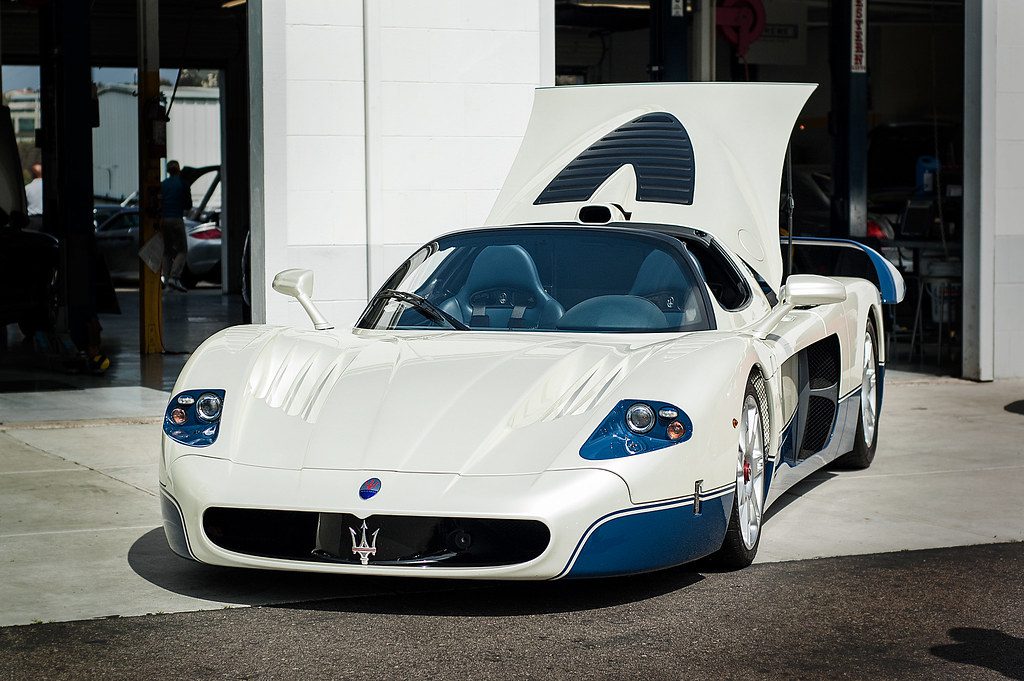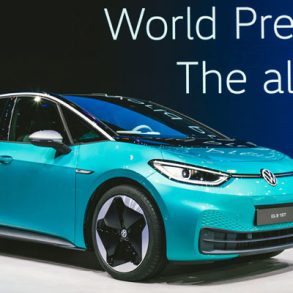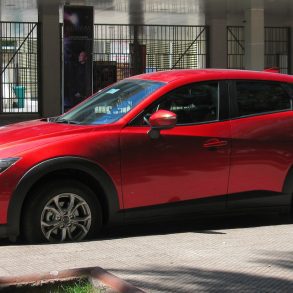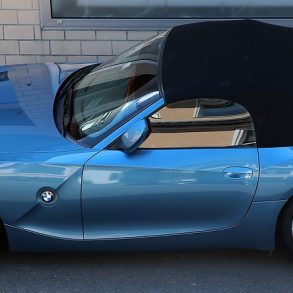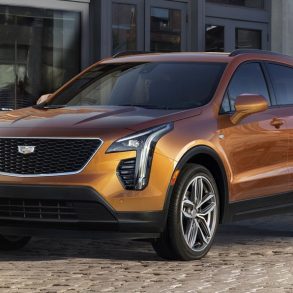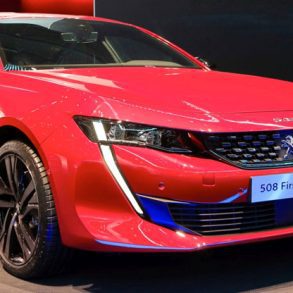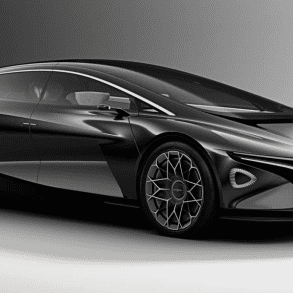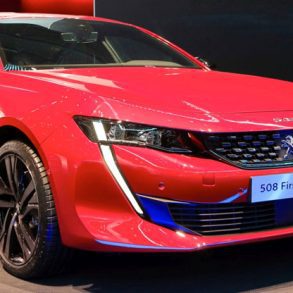The Geneva Auto Show in the beginning of March is very likely to be the place with the highest density of supercars and concept cars in Europe at that moment. Even the smallest manufacturers, tuners and designers make it to the showfloor each year to show off their latest creations and try to steal some of the limelight from the major brands. That leads to an interesting mix that caters to everyone, from mainstream mass-production to hyperexclusive, from realistic to futuristic, and of eyepoppingly beautiful to eyewateringly unsightly. All this contrast means everyone must have an opinion, love it, hate it, or totally indifferent. We also loved a few, but not all of them. Here are a the ones that stirred us the most, be it in a good or a bad way.
Ferrari 812 Superfast
Bart: hot
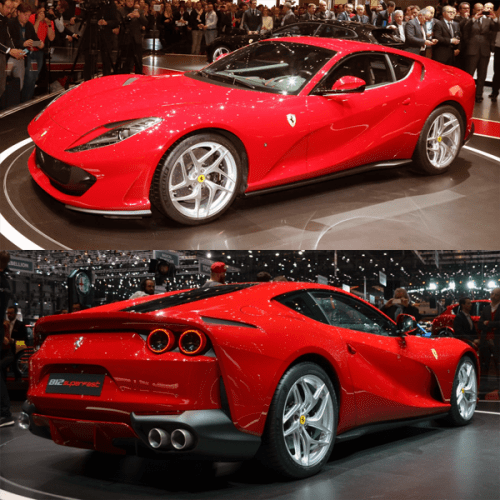 Is it an extensive facelift of the F12 or a completely new model? Ferrari wants you to believe the latter and has given the model a new name. And although the overall proportions and silhouette are very similar to the F12, the aerodynamics and engine are completely overhauled. At 800hp and 718Nm (529 lb.-ft), the engine is Ferrari’s most powerful V12 engine ever built. Displacement grew to 6,5 liters which means it has an output of 123hp per liter, the highest of any non-hybrid, naturally aspirated production engine ever made. The aerodynamics are another awesome feature of the 812 Superfast, as Ferrari strives to create downforce without using additional wings. There are a number of gaps in the front and side of the bodywork to create additional downforce, reduce drag or cooling purposes. Some are even equipped with active flaps to change the airflow through or under the car to fulfill different purposes at different speeds. The Ferrari mid/front engined V12 has always been the showcase of what the brand is capable of, but this time I watched in awe when they explained the aerodynamics and performance of the 812 Superfast.
Is it an extensive facelift of the F12 or a completely new model? Ferrari wants you to believe the latter and has given the model a new name. And although the overall proportions and silhouette are very similar to the F12, the aerodynamics and engine are completely overhauled. At 800hp and 718Nm (529 lb.-ft), the engine is Ferrari’s most powerful V12 engine ever built. Displacement grew to 6,5 liters which means it has an output of 123hp per liter, the highest of any non-hybrid, naturally aspirated production engine ever made. The aerodynamics are another awesome feature of the 812 Superfast, as Ferrari strives to create downforce without using additional wings. There are a number of gaps in the front and side of the bodywork to create additional downforce, reduce drag or cooling purposes. Some are even equipped with active flaps to change the airflow through or under the car to fulfill different purposes at different speeds. The Ferrari mid/front engined V12 has always been the showcase of what the brand is capable of, but this time I watched in awe when they explained the aerodynamics and performance of the 812 Superfast.
Kriss: so-so
I am less than smitten with the new Ferrari. I agree with Bart that the F812 Superfast boasts some impressive figures and aerodynamic solutions. Crucially, though, to me the F812 has taken a backward step looks-wise: its surfaces are busier and more complicated than on the F12, and it also boasts the new corporate tail end for the front-engined models with quad lamps that simply l took too small and weak. Combined with what I perceived as a backward step look-wise from the F599 to the F12, and I feel like the Front-engines Ferraris have been getting less attractive with each generation. Not a good sign for a brand that sells cars so much based on the emotive “I want one” factor, especially as their main competitor, Lamborghini, finally seems to have sorted the Aventador, not to mention made it even better-looking. Oh, and Superfast may be the stupidest name ever given to a Ferrari – did they run out of evocative names like Maranello, Italia etc.?
McLaren 720S
Kriss: hot
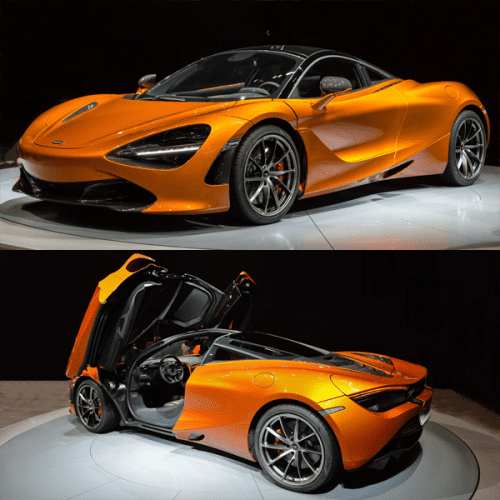 I was not a huge fan of the first-generation of Super Sports cars from McLaren – the MP4-12C / 12C was a soapy “met too” design, and was only slightly improved upon by the 650S that replaced it. The 720S is, to my eyes, a huge step in the right direction. For starters, it bares more than a passing resemblance to the P1, without doubt the most striking and distinctive of the first-generation McLaren cars. This includes a low, aggressive front, a cockpit section whose plentiful glazing looks not unlike that of a jet plane and gives the driver great visibility, and a very distinctive rear that blends the functional vents and hydraulically-operated rear spoiler/airbrake with stylish LED rear lamps that are now a McLaren calling card. But the biggest improvement is the profile with blades behind the front wheels followed by a sinuous side-treatment does away with air intakes much like the Ferrari 458 Italia and, to an extent, Lamborghini Huracan did (though Ferrari inexplicably brought them back for the 488 GTB). That the construction (carbon-fiber tub), performance (0-60mph in 2.8s) and promised vehicle dynamics (slip control) seem like something only limited-run supercars offered a decade ago (seriously, look up the stats for Ferrari Enzo) is simply a cherry on top. Ferrari and McLaren were already looking nervously over their shoulder – now they may be eating dust of the car ahead of them!
I was not a huge fan of the first-generation of Super Sports cars from McLaren – the MP4-12C / 12C was a soapy “met too” design, and was only slightly improved upon by the 650S that replaced it. The 720S is, to my eyes, a huge step in the right direction. For starters, it bares more than a passing resemblance to the P1, without doubt the most striking and distinctive of the first-generation McLaren cars. This includes a low, aggressive front, a cockpit section whose plentiful glazing looks not unlike that of a jet plane and gives the driver great visibility, and a very distinctive rear that blends the functional vents and hydraulically-operated rear spoiler/airbrake with stylish LED rear lamps that are now a McLaren calling card. But the biggest improvement is the profile with blades behind the front wheels followed by a sinuous side-treatment does away with air intakes much like the Ferrari 458 Italia and, to an extent, Lamborghini Huracan did (though Ferrari inexplicably brought them back for the 488 GTB). That the construction (carbon-fiber tub), performance (0-60mph in 2.8s) and promised vehicle dynamics (slip control) seem like something only limited-run supercars offered a decade ago (seriously, look up the stats for Ferrari Enzo) is simply a cherry on top. Ferrari and McLaren were already looking nervously over their shoulder – now they may be eating dust of the car ahead of them!
Bart: so-so
As opposed to Kriss, I’ve been a big fan of the recent McLaren designs as they had an easily recognizeable fascia and a clean look. The new 720S, which replaces the 650S, is a step in the wrong direction for my taste. The front now looks too “generic supercar startup” for my liking, it could be a Techrules or a Zenvo, while I thought McLaren had moved way past that start-up phase into more mature design. Having said that, the engineering makes up for a lot of the front styling, and so does the folding driver display. Why hasn’t anybody thought of this before? Just get the basic information without distraction, until you press a button and the display folds up to reveal all the other information. The performance makes the Ferrari 488GTB look bleak as it’s more powerful and weighs 90kg less, giving it a 0-200km/h time of half a second faster and even slightly faster than the McLaren 675LT. So perhaps the 720S sets the new standard for its class thanks to its 720hp and 770Nm (568 lb.-ft) from a 4-liter twin-turbo V8. So, all-in-all I have mixed feelings for it. Brilliant engineering, questionable design.
Spyker C8 Preliator Spyder
Bart: hot
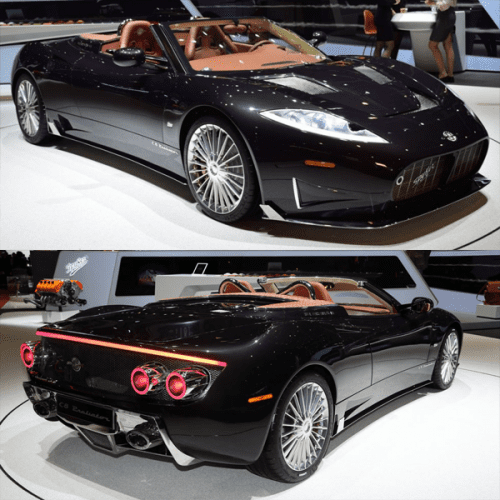 We all know Spyker builds some of the best looking interiors in the industry. If you don’t, just look at the shifter and you’ve seen enough. We also know they somehow seem to have survived the debacles of expensive ventures into Formula One, Le Mans sportscar racing and the takeover of virtually bankrupt Saab. At least Spyker’s catchphrase “Nulla tenaci invia est via” (Latin for “For the tenacious, no way is impassable”) doesn’t seem hollow. Last year in Geneva they showed the C8 Preliator and sold all 50 planned units within a few months (although production hasn’t started yet), this year they brought the Spyder version which is perhaps even better looking with its leather cover. But the biggest news is not the roof, it’s under the hood: for the first time a modern-day Spyker won’t be powered by an Audi engine, as the brand signed an engine supply deal with Koenigsegg for a 5-liter naturally aspirated V8 with 600hp and 600Nm (442 lb.-ft) to power all 50 Preliator Coupes and all 100 Preliator Spyders, all with manual gearboxes.
We all know Spyker builds some of the best looking interiors in the industry. If you don’t, just look at the shifter and you’ve seen enough. We also know they somehow seem to have survived the debacles of expensive ventures into Formula One, Le Mans sportscar racing and the takeover of virtually bankrupt Saab. At least Spyker’s catchphrase “Nulla tenaci invia est via” (Latin for “For the tenacious, no way is impassable”) doesn’t seem hollow. Last year in Geneva they showed the C8 Preliator and sold all 50 planned units within a few months (although production hasn’t started yet), this year they brought the Spyder version which is perhaps even better looking with its leather cover. But the biggest news is not the roof, it’s under the hood: for the first time a modern-day Spyker won’t be powered by an Audi engine, as the brand signed an engine supply deal with Koenigsegg for a 5-liter naturally aspirated V8 with 600hp and 600Nm (442 lb.-ft) to power all 50 Preliator Coupes and all 100 Preliator Spyders, all with manual gearboxes.
Kriss: hot
I have to admit that I was never 100% sold on Spyker’s cars – between their almost too-cool interiors and a “pedestrian” Audi engine they seemed like cars for people who valued style over substance. But now the new engine that made its debut in the Spyder changes all that – for a company to roll out a purpose-designed naturally-aspirated V8 in an era of turbocharged supercars is both ballsy and appealingly counter-cultural, exactly what you’d want from a carmaker with Spyker’s niche appeal. I just hope the engine’s reliability is up to scratch, and does not follow the (literally) explosive fate of the once-promising purpose-designed V8 that Lotus put in its Esprit in the late 1990s.
Aston Martin Valkyrie
Kriss: hot
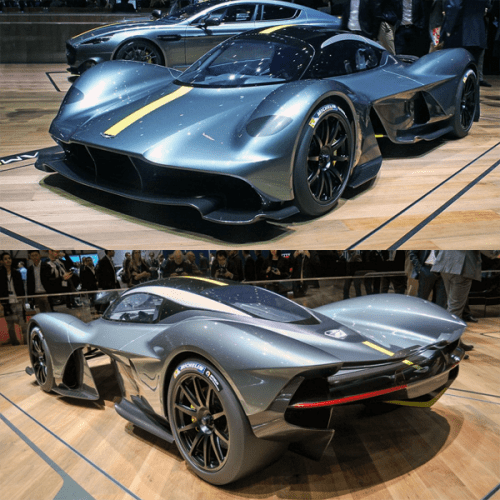 The Aston Martin / Red Bull collaboration got me excited from the moment it was announced. In one corner you have Aston Martin, which beside making comfy GTs has also given us some of the most desirable and limited-run cars: One-77 and the Vulcan (greatly under-appreciated both, in my opinion). In the other you have Adrian Newey, arguably the greatest F1 designer since Gordon Murray, the men who gave us the McLaren F1. While it was previously shown only as a styling/layout proof-of-concept sculpture, Aston Martin announced in Geneva that the newly-christened Valkyrie (badass name!) would be powered primarily by a screaming 6.5-liter V12 delivering approximately 900hp, whose specific output of 138hp per liter will easily eclipse the 123hp per liter of the F812 Superfast. Listen to a clip of the 6.5 liter, 800hp V12 Vulcan at full tilt and you have to wonder whether the Valkyrie will wipe the floor with the upcoming Mercedes-AMG hypercar in terms of emotional appeal, despite the latter supposedly packing the actual engine from Lewis’s F1 car (albeit adapted for the road). There was never a better time to be a super-rich car enthusiast with $3-5 million burning a hole in your pocket!
The Aston Martin / Red Bull collaboration got me excited from the moment it was announced. In one corner you have Aston Martin, which beside making comfy GTs has also given us some of the most desirable and limited-run cars: One-77 and the Vulcan (greatly under-appreciated both, in my opinion). In the other you have Adrian Newey, arguably the greatest F1 designer since Gordon Murray, the men who gave us the McLaren F1. While it was previously shown only as a styling/layout proof-of-concept sculpture, Aston Martin announced in Geneva that the newly-christened Valkyrie (badass name!) would be powered primarily by a screaming 6.5-liter V12 delivering approximately 900hp, whose specific output of 138hp per liter will easily eclipse the 123hp per liter of the F812 Superfast. Listen to a clip of the 6.5 liter, 800hp V12 Vulcan at full tilt and you have to wonder whether the Valkyrie will wipe the floor with the upcoming Mercedes-AMG hypercar in terms of emotional appeal, despite the latter supposedly packing the actual engine from Lewis’s F1 car (albeit adapted for the road). There was never a better time to be a super-rich car enthusiast with $3-5 million burning a hole in your pocket!
Bart: hot
What can I add that Kriss hasn’t said already? Aston Martin has basically given us a glimpse into its future and it promises to be great. In fact, if there was never a better time to be a super-rich car enthusiast, I also think the future has never looked better for Aston Martin. They’ve got a whole line-up of 7 supercars coming up and CEO Andy Palmer has promised the brand will keep fitting manual gearboxes into their cars. Back to the Valkyrie, which promises to remain exclusive with a production run of 150 units (+25 trackracers), all of which have already been sold, of course. This car looks as intimidating as it can be, and it was by far the showstopper in Geneva. If you thought the 812 Superfast’s aerodynamics were impressive, take this: without any wings, the Valkyries’s advanced underbody air channel design will create up to 1.800kg (4,000 lb.) of downforce without the use of a large rear wing or any clearly visible aerodynamic aids. As a result, the Valkyrie can achieve up to 4 G of lateral acceleration, more than an F1 car’s 3,5 G. An F1-style energy recovery system helps the engine to even more impressive performance to help achieve a 1-to-1 power to weight ratio (1hp per kilo), similar to the Koenigsegg One:1 but rumors are the Valkyrie can beat that car’s 0-300km/h (0-187mph) time of 12 seconds thanks to its phenomenal grip.
Italdesign Zerouno
Bart: not
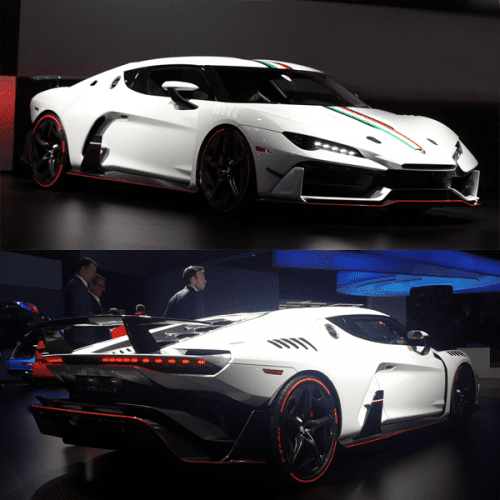 What does VW Group want with this car? Well, they want to show Italdesign Automobili Speciali as their new bespoke brand for ultra low-volume supercars. If that’s the aim, they’ve failed miserably. If I said the McLaren 720S looks too much generic supercar startup from the front, the Zerouno looks it from every angle. It looks like a home-built replica with some inspiration from Lamborghini’s extreme design language. They’re building 5 pieces ained at collectors which hope the limited production will cause prices to rise over time, but although Italdesign is a well-known and respected design company, responsible for cars like the Maserati MC12, I’m not sure if it’s established enough as a supercar brand itself to create such a hype around the Zerouno (Italian for zer one).
What does VW Group want with this car? Well, they want to show Italdesign Automobili Speciali as their new bespoke brand for ultra low-volume supercars. If that’s the aim, they’ve failed miserably. If I said the McLaren 720S looks too much generic supercar startup from the front, the Zerouno looks it from every angle. It looks like a home-built replica with some inspiration from Lamborghini’s extreme design language. They’re building 5 pieces ained at collectors which hope the limited production will cause prices to rise over time, but although Italdesign is a well-known and respected design company, responsible for cars like the Maserati MC12, I’m not sure if it’s established enough as a supercar brand itself to create such a hype around the Zerouno (Italian for zer one).
Kriss: not
Oh dear! Just when you thought VW Group was a good custodian of Italian brands (Lamborghini, Ducati), here comes this… thing. Looking like a hodgepodge compilation of rejected design elements from design proposals for an upstart supercar maker from a car with no experience in designing cars, the Zerouno is an absolute disappointment to me. Add to that the fact that it is powered by a “mere” V10 from the base Huracan, the fact that its pedestrian 0-62mph (0-100 km/h) time of 3.2 seconds is easily eclipsed by the 2.9 second time of the Huracan Performante, and the mooted $1.6 million price tag and the Zerouno is the undisputed winner of the Geneva Autoshow wooden spoon for me…
Tamo Racemo and Racemo+ by Tata
Kriss: hot
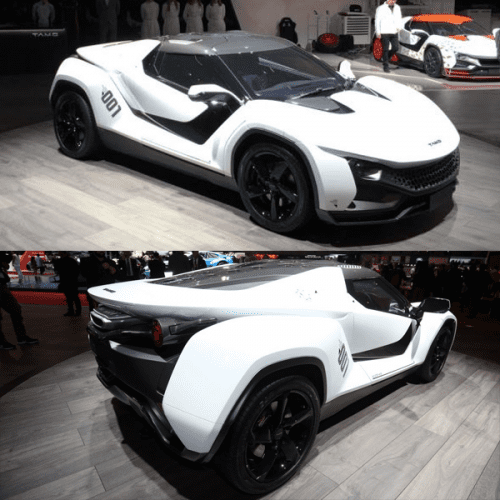 I admit I may be grading on a bit of a curve here, but the Racemo twins are one hell of a start out of the gates for Tata’s nascent Tamo brand. With its squat mid-engined stance and semi-offroad design cues reminiscent of the Lancia Stratos and the Italdesign Parkour the Racemo looks purposeful, dynamic, and most importantly original. Add to that the tiny 3-cyl 1.2 liter engine good enough for 190hp that is very in keeping with the zeitgeist and the Racemo is my surprise concept/supercar of Geneva’17.
I admit I may be grading on a bit of a curve here, but the Racemo twins are one hell of a start out of the gates for Tata’s nascent Tamo brand. With its squat mid-engined stance and semi-offroad design cues reminiscent of the Lancia Stratos and the Italdesign Parkour the Racemo looks purposeful, dynamic, and most importantly original. Add to that the tiny 3-cyl 1.2 liter engine good enough for 190hp that is very in keeping with the zeitgeist and the Racemo is my surprise concept/supercar of Geneva’17.
Bart: hot
I totally agree with Kriss on every point for this one. The Racemo is a great way to put the new Tamo brand on the map. Tamo is launched as Tata’s a proving ground for new and innovative ideas and in that light the Racemo is perhaps even a bit conservative. Sure, as Kriss said, it’s very today but it’s not very future for a brand that aims to be exactly that. But what am I complaining about? This is a small (shorter but wider than an MX-5) sportscar that looks awesome and will be built in a limited run of 250 copies. Where can I sign up?
Citroën C-Aircross
Bart: hot
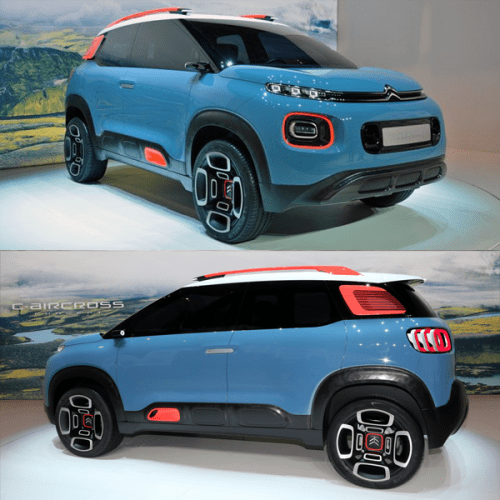 The C-Aircross manages looks cuddly and inoffensive but still sturdy and like a real crossover, and it’s a relief to see the actual production C-Aircross is likely to look so much more funky than the somewhatawkwardly proportioned Opel/Vauxhall Crossland X even though they share a platform. On the other hand, the C-Aircross shares more than a few resemblances with the C4 Cactus and that car has unfortunately proven its design doesn’t have a long shelf life. Not that I think it’s become stale and looking old, but after a short peak its sales are already starting to fall. Still, Citroën seems eager to hold on to its new design language, which includes the protective airbumps along the flanks, the squinting “eyes” that visually exend the grille and squircles all around. I like it, and Citroën desperately needs some crossovers in its line-up, so to me it’s a winner.
The C-Aircross manages looks cuddly and inoffensive but still sturdy and like a real crossover, and it’s a relief to see the actual production C-Aircross is likely to look so much more funky than the somewhatawkwardly proportioned Opel/Vauxhall Crossland X even though they share a platform. On the other hand, the C-Aircross shares more than a few resemblances with the C4 Cactus and that car has unfortunately proven its design doesn’t have a long shelf life. Not that I think it’s become stale and looking old, but after a short peak its sales are already starting to fall. Still, Citroën seems eager to hold on to its new design language, which includes the protective airbumps along the flanks, the squinting “eyes” that visually exend the grille and squircles all around. I like it, and Citroën desperately needs some crossovers in its line-up, so to me it’s a winner.
Kriss: so-so
The Citroën C-Aircross is a thinly-veiled concept version of the upcoming C3 Picasso, which is about to make the leap from MPV to crossover much like its Peugeot 3008/5008 have done. Moderately attractive as far as small crossover concepts go, the C-Aircross gives me hope that Citroën can inject the production version with a bit more visual cohesion than Opel/Vauxhall managed with its platform twin, the Crossland X. Still, I will mourn the passing of the first-generation C3 Picasso, a car for which I always had a big soft spot.
Peugeot Instinct Concept
Kriss: hot
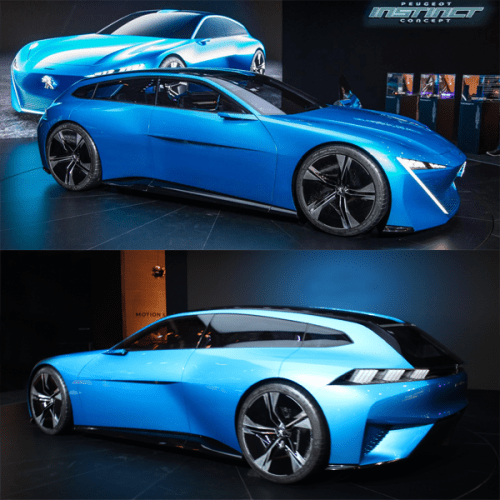 There is no two ways about it: Peugeot’s Instinct Concept is one hell of a great-looking car. For starters it has a stance to die for: wide, low, with ridiculously large wheels and a longish rear overhang that accentuates its shooting brake shape and puts the Panamera Sport Turisimo’s boring shape to shame. Then there are the details, like the front and rear lights, that promise a nicely aggressive new design language for future Peugeot models. The only thing I’m worried is the “vampire fang” vertical light component that does not work great on production models (think: Renault Megane, Cadillac CTS), but hopefully Peugeot will be the first one to pull it off.
There is no two ways about it: Peugeot’s Instinct Concept is one hell of a great-looking car. For starters it has a stance to die for: wide, low, with ridiculously large wheels and a longish rear overhang that accentuates its shooting brake shape and puts the Panamera Sport Turisimo’s boring shape to shame. Then there are the details, like the front and rear lights, that promise a nicely aggressive new design language for future Peugeot models. The only thing I’m worried is the “vampire fang” vertical light component that does not work great on production models (think: Renault Megane, Cadillac CTS), but hopefully Peugeot will be the first one to pull it off.
Bart: hot
The Peugeot Instinct Concept is much more concept car than the Citroën C-Aircross, which is just a production model in its final (minor) disguise. The Instinct is more of a technological showcase, but is also said to hint at the next generation Peugeot 508. And PSA seems to have learned that it just can’t compete in the shrinking mainstream midsized segment with just another sedan (they have the Opel/Vauxhall Insignia for that purpose now), so let’s hope the sexy silhouette of the Instinct makes it into production reality. About the technology: the name Instinct hints at an autonomous car that adapts to the preferences of its user based on the information from his/her smartphone and other devices, agenda etc. P.e. If your smartwatch shows you just had a tough workout, the Instinct could automatically choose a Soft Autonomous mode so you can relax. Both the steering wheel and gas pedal are retractable for Full Autonomous mode. And while the design is actually pretty realistic and some of it may appear on the next 508, the technology won’t make it in showrooms before 2025.
Mercedes-AMG GT Concept
Bart: hot
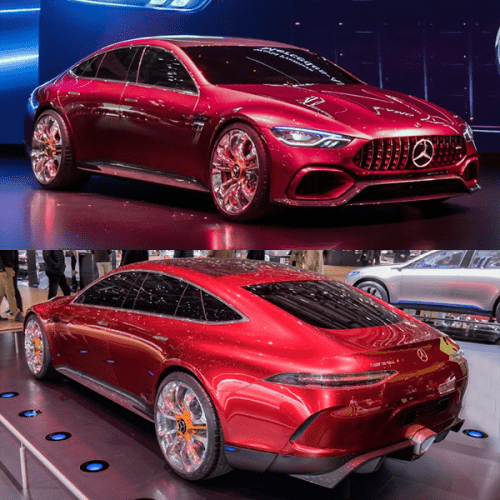 Why is this still a concept and not a production model? It looks so production ready to me and it’s a disappointment that this vehicle isn’t going to be on the road within a few months. Sure, its technology is still in development but why not launch it with just the same conventional powertrain as the AMG GT Coupe before adding the 815hp 4-liter V8 biturbo hybrid which accelerates from 0-100km/h in less than three seconds? It’s every bit as sexy as you’d expect from a four-door AMG GT and I really like the sharper nose, which I hope makes it to the two-door versions too. This is how a four-door sports coupe is done, Aston Martin Rapide and Porsche Panamera ST!
Why is this still a concept and not a production model? It looks so production ready to me and it’s a disappointment that this vehicle isn’t going to be on the road within a few months. Sure, its technology is still in development but why not launch it with just the same conventional powertrain as the AMG GT Coupe before adding the 815hp 4-liter V8 biturbo hybrid which accelerates from 0-100km/h in less than three seconds? It’s every bit as sexy as you’d expect from a four-door AMG GT and I really like the sharper nose, which I hope makes it to the two-door versions too. This is how a four-door sports coupe is done, Aston Martin Rapide and Porsche Panamera ST!
Kriss: hot
When I heard that Mercedes-AMG is readying a four-door car loosely based on its GT sports car I was really worried – at best it would turn out semi-attractive, like the sedan versions of the Ferrari 456 that the Sultan of Brunei had made, and at worst it would look like the ridiculous renders of a four-door Lamborghini Aventador or Bugatti Veyron that make their rounds on the internet every now and then. So color me surprised when I saw the final product – that is one great-looking car! Sure, from the rear it owes more to the Audi A7 than its GT brother (in fact its shape is very reminiscent of the A7), but the overall look is cohesive, dynamic and surprisingly un-fussy for a modern Mercedes. My only worry is that this model will end up merely “inspiring” design elements on the next CLS, rather than ending up as a dedicated Porsche Panamera competitor it deserves to become.
Pininfarina H600
Bart: not
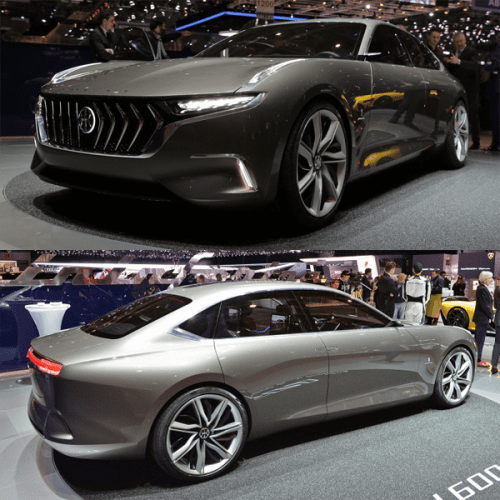 The H600 is a concept car by Pininfarina which was ordered by Hybrid Kinetic Group of China to showcase their hybrid drivetrain with a micro-turbine range extender. The problem is, we can’t see that drivetrain, nor do we get any specific information about it, so basically it’s no more than a celebration of this new cooperation. Hybrid Kinetic Group is run by the man behind Brilliance Automotive which produces the BMWs for the local Chinese market, including cars under its own brand, though not very successfully. The company says it will work on a number of cars with this power train in the next few years together with Pininfarina, which is now owned by Mahindra & Mahindra of India, also the owners of SsangYong. If we don’t know anything about the technology, we’ll have to focus on the design. And although the package actually looks pretty graceful and clean, it can’t be called very original by any measure. The grille is easily recognizeable as Maserati (Levante), the rear could be Lincoln, there are some lines that remind of Volvo and the roofline has a hint of Jaguar. Then there are the stretched headlights that merge with the grille, a styling cue that’s becoming more common these days. Not necessarily a bad look but it’s far from original.
The H600 is a concept car by Pininfarina which was ordered by Hybrid Kinetic Group of China to showcase their hybrid drivetrain with a micro-turbine range extender. The problem is, we can’t see that drivetrain, nor do we get any specific information about it, so basically it’s no more than a celebration of this new cooperation. Hybrid Kinetic Group is run by the man behind Brilliance Automotive which produces the BMWs for the local Chinese market, including cars under its own brand, though not very successfully. The company says it will work on a number of cars with this power train in the next few years together with Pininfarina, which is now owned by Mahindra & Mahindra of India, also the owners of SsangYong. If we don’t know anything about the technology, we’ll have to focus on the design. And although the package actually looks pretty graceful and clean, it can’t be called very original by any measure. The grille is easily recognizeable as Maserati (Levante), the rear could be Lincoln, there are some lines that remind of Volvo and the roofline has a hint of Jaguar. Then there are the stretched headlights that merge with the grille, a styling cue that’s becoming more common these days. Not necessarily a bad look but it’s far from original.
Kriss: so-so
The Pininfarina H600 is a bit of a mixed bag. On one hand it looks rather good, a bit like an “Italian Tesla” as some of the internet commentators have remarked, and promises a 2.9 sec 0-62mph (100 km/h) run courtesy of its 800hp electric engines aided by a micro-turbine range-extender, much like that promised by Jaguar in its C-X75 concept car. On the other hand I can’t shake off the feeling that the car could have, and should have, looked better given Pininfarina’s heritage, with a front that looks a bit too much like the Maserati Levante and a super-boring rear. In fact, the design effort reminds me a bit of sub-par designs that Italian designers produced for mainstream brands in the 90s, like the rejected Citroen Xantia / production Daewoo Espero design from Bertone, or the Jaguar Kensington / Daewoo Leganza design from Italdesign. The interior too is a bit too gauche as well for my taste, a bit like a Lincoln concept, but hey – if the Hong Kong engineering company behind the car could deliver on the performance/engineering claims than this could be a very interesting car (this is not beyond the realm of possibility, given the amazing things some Chinese carmakers seem to be achieving with their electric sports cars).

